The Intel SSD 510 Review
by Anand Lal Shimpi on March 2, 2011 1:23 AM EST- Posted in
- IT Computing
- Storage
- SSDs
- Intel
- Intel SSD 510
Overall System Performance using PCMark Vantage
Next up is PCMark Vantage, another system-wide performance suite. For those of you who aren’t familiar with PCMark Vantage, it ends up being the most real-world-like hard drive test I can come up with. It runs things like application launches, file searches, web browsing, contacts searching, video playback, photo editing and other completely mundane but real-world tasks. I’ve described the benchmark in great detail before but if you’d like to read up on what it does in particular, take a look at Futuremark’s whitepaper on the benchmark; it’s not perfect, but it’s good enough to be a member of a comprehensive storage benchmark suite. Any performance impacts here would most likely be reflected in the real world.
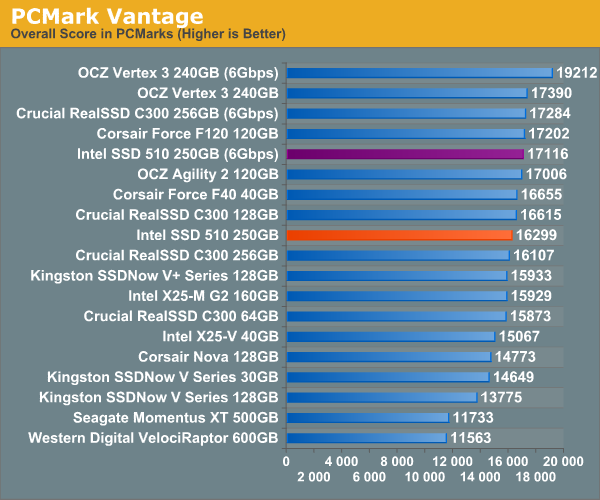
PCMark Vantage doesn't look too good paired with the 510. On a 6Gbps controller the Intel SSD 510 performs in line with the 3Gbps Vertex 3, however the 6Gbps Vertex 3 is untouchable. And over a 3Gbps interface the 510 is no better than a C300.
The pure HDD tests (below) are, at best, SF-1200 level. The SF-2200 is untouchable here. Based on what we've seen thus far I'm guessing this has a lot to do with the random read performance of the 510 once more.
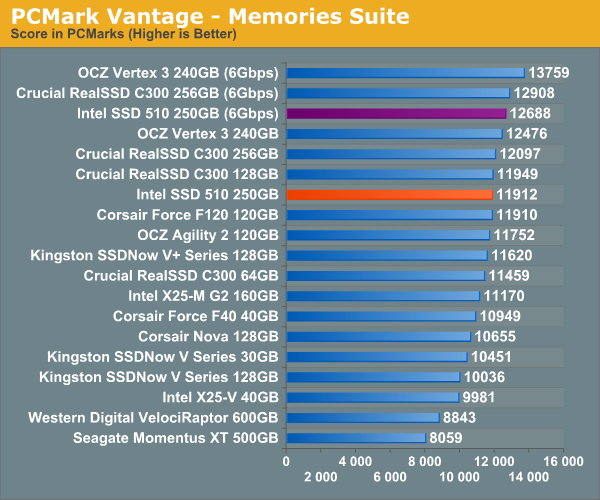
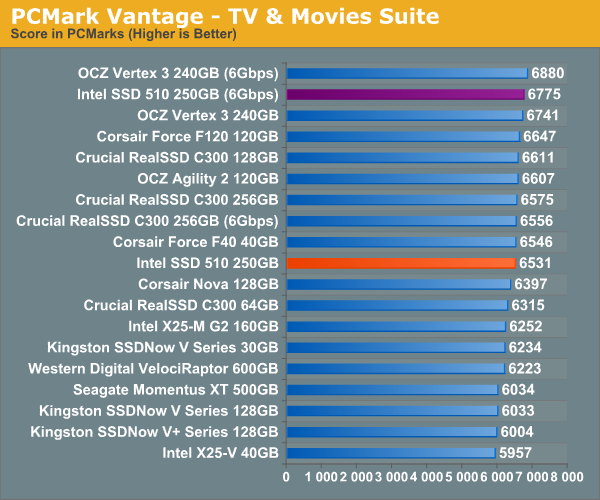
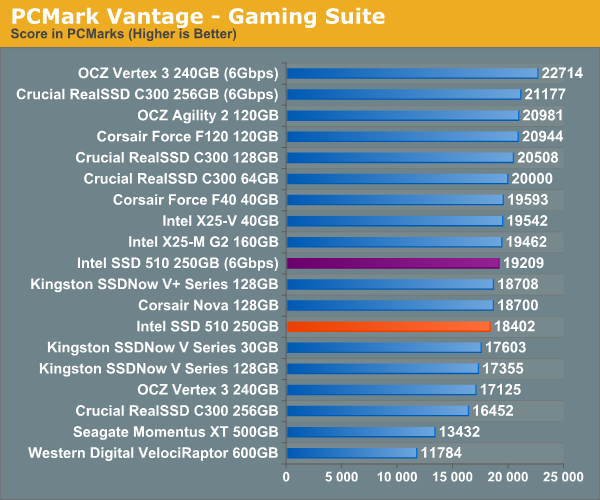

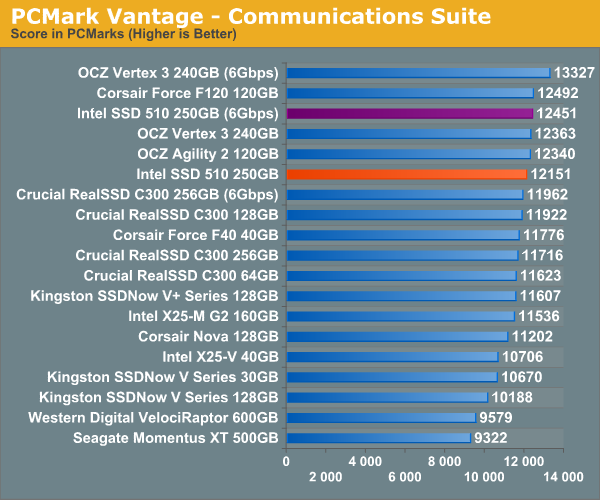
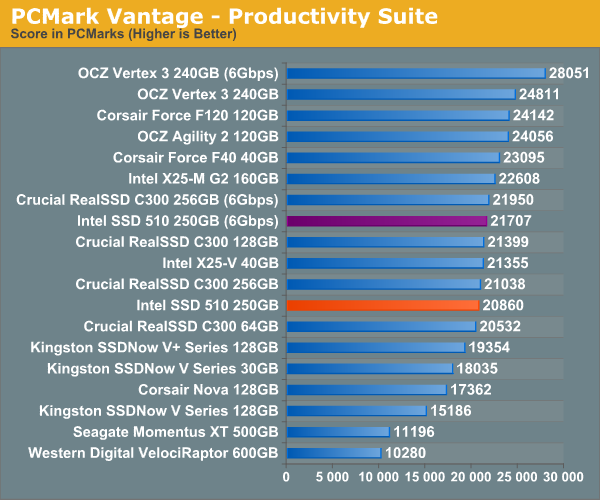
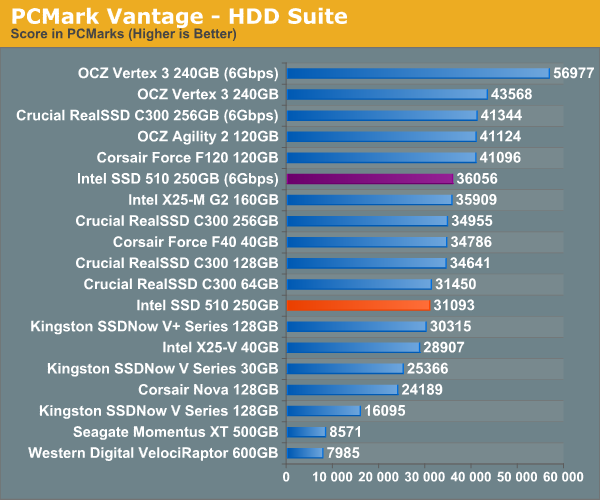










128 Comments
View All Comments
lyeoh - Wednesday, March 2, 2011 - link
Oh yeah, thanks for the max latency figures. They're very useful.The G2's max of 900ms is quite a long time. Nearly a second! What are the max latencies for say a velociraptor in similar tests? I know the theoretical figures would be based on seek time + RPM but often theory is different from practice.
I find it interesting that the Crucial RealSSD C300 does worse than the Intel SSD 510 in the "Anand Storage Bench 2011- Heavy Workload" despite getting better numbers in the random and sequential tests. Any idea why this would be so? Poorer max latency?
jimhsu - Wednesday, March 2, 2011 - link
Poorer sequential performance I guess. The C300 (which I just got) is very fast, but the sequential perf of the 510 is simply better, which impacts a lot of the sequential portion of the workload test. Random performance in typical desktop models has reached somewhat of a plateau, particularly since most applications currently out there are optimized for the dog-slow random performance of consumer hard drives.Creepwood - Friday, March 4, 2011 - link
About reliability/compatibility: have you tested this drive in the new Sandy Bridge Macbook Pro? Any issues?davepermen - Monday, March 7, 2011 - link
Interestingly, one of THE main performance cases is when you need to quickly write lots of stuff, like in video editing. And there, all data is at least partially compressed, so i guess there the intel will be in a better place.RaistlinZ - Wednesday, March 2, 2011 - link
Intel is going to have to price this thing cheaper than the Vertex 3, or any other new Sandforce SSD for that matter. They can't use performance as a selling point. I'm sure the new SF controller will offer good stability. Unless you're an Intel fanboy I don't see any reason to get the 510 over the Vertex 3, unless they price it much lower.semo - Wednesday, March 2, 2011 - link
This is an Atom alright!I think the conclusion, although critical in places was overall mild. “It looks like we may have hit the upper limit of what we need from 4KB random write performance”… Yeah, in the consumer/budget space. But what consumer/budget computer user would buy a 250GB SSD. I’ve managed to convince a few of my clients to go with an “expensive upgrade” and in the end they’ve been extremely happy… In those cases I’ve only installed 64GB drives.
At the moment SSDs are NOT mainstream and it’s mostly the enthusiast and pro crowd that will be buying consumer grade SSDs. I’ll be using my SSD for VMs for testing and studying and I do a lot of heavy random IO operations.
For a drive as big and as expensive as the 250GB 510, I expect much better across-the-board performance.
TSnor - Wednesday, March 2, 2011 - link
Hi, the article states "~900ms write operation, the 510 keeps the worst case latency to below 400ms. The Vertex 3 by comparison has a max write latency of anywhere from 60ms - 350ms"microseconds are usually abbreviated us, where the u has a funny tail on it. (the u is greek for something)
ms usually means milliseconds. I usually type 'mics' when on the keyboard and reserve the funny u for when handwriting. example, a good SSD write takes less then 100 mics.
saying something is around 900 ms means it takes about a second.
epicsnackus - Wednesday, March 2, 2011 - link
The article is correct, the numbers are really in milliseconds. The microsecond numbers you're thinking of are 1) best case, and 2) usually readsChloiber - Wednesday, March 2, 2011 - link
"Write speed with fully incompressible data is easily a victory for the SF-2200 based OCZ Vertex 3."I think you meant fully compressible?
Anand Lal Shimpi - Wednesday, March 2, 2011 - link
Fixed! Thank you :)Take care,
Anand